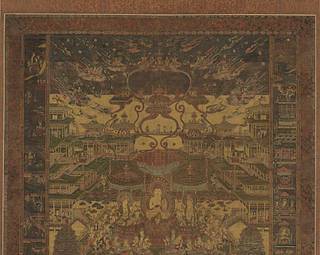
Similar
当麻曼荼羅図|Taima Mandala - Public domain dedication. Metropolitan Museum of Art image.
Summary
Public domain photo of a rug, fabric, Japan, free to use, no copyright restrictions image - Picryl description
Mandala is a representation of the universe and of enlightenment. In two-dimensional form, it looks as circles enclosed in squares drawing. Thangka and Mandala both belong to the visual category of the art of Buddhist enlightenment. Topics of thangkas include Buddhas, bodhisattvas, Dharma protectors, masters, mandala... Thangkas of meditation deities also serve as a tool for visualization during meditation, by helping the practitioner getting used to the different states of the mind. Dating back to the 7th century A.D, thangka painting is one of the greatest art forms of Asia. Thangkas are considered Buddhist iconography, each painting will symbolically represent divinities and passages based on the teachings of the Buddha.
Mandalas are Buddhist devotional images often deemed a diagram or symbol of an ideal universe. Mandalas come in many forms. Often they are painted on scrolls and taken with travelers over long distances across the Eurasian continent. Learn more about Buddhism through understanding one of its more iconic artworks. A mandala is a symbol of the universe in its ideal form, and its creation signifies the transformation of a universe of suffering into one of joy. It can also be used as an aid to meditation, helping the meditator to envision how to achieve the perfect self. Mandalas were created in the service of one of the world's great religions, Buddhism. They were produced in Tibet, India, Nepal, China, Japan, Bhutan, and Indonesia and date from the 4th century to present. Now they are created throughout the world, including New York City. A special sand mandala painting is a gift to New York City from the Tibetan Buddhist monks of Drepung Loseling Monastery as a tolken of healing and goodwill following the terrorist act against the city on September 11, 2001. The construction of the mandala begins with a ceremony in which the monks consecrate the site and call forth forces of goodness through chants, meditation, and music. Then, over the course of ten days, the monks will pour millions of grains of colored sand from traditional metal funnels (chak-purs), purifying and healing the space and its inhabitants in the process. Shortly after its completion the monks will dismantle the mandala to symbolize the impermanence of all that exists and disperse the sand in order to share its blessing.
Tags
Date
Source
Copyright info










































